- Prelude
- Editorial
- Subodh's 'return home'
- A Conversation with TV Santosh
- It's a War Out There
- Raqib Shaw
- Illusions in Red from a very British Indian Sculptor
- Stand Alone: Shibu Natesan
- Reading Atul Dodiya
- Bharti Kher: An Obsession for Bindis
- Bose Krishnamachari
- The Image - Spectacle and the Self
- From Self-depiction to Self-reference: Contemporary Indian Art
- GenNext: The Epitome of New Generation Art
- Kolkata's Contemporary Art A Look in the Mirror
- Innovation Coalesced with Continuing Chinese Qualities
- Kala Bhavana-Charukala Anushad Exchange Program
- Montblanc Fountain Pens
- Dutch Designs: The Queen Anne Style
- Bangalore Dance Beat
- Decade of change
- Distance Between Art & It's Connoisseur
- What Happened and What's Forthcoming
- 3rd India Art Summit
- New Paradigms of the Global Language of Art
- Black Brown & The Blue: Shuvaprasanna
- Art Events Kolkata
- Musings from Chennai
- Art Bengaluru
- Printmaker's Season
- Mumbai Art Sighting
- The Pause of Profound Stillness
- Previews
- In the News
- The Rebel Queen: An icon of her own times yet looked down upon
ART news & views
GenNext: The Epitome of New Generation Art
Volume: 3 Issue No: 14 Month: 3 Year: 2011
by Sarmistha Maiti
GenNext has eventually grown into the indispensable metaphor of new generation art. The curatorial endeavour has completely got re-oriented and revolutionized in the creative spree of young minds through its shows and eventually created a unique discourse to make its way into the pages of art history of the world. GenNext was conceptualized as the annual show of the Aakriti Art Gallery, Kolkata when it completed one year of its thriving in the art world. The show from the level of its inception was designed with a difference where the prime focus was on the young generation artists below forty and the process of bringing them together was through selection by a panel of judges including artists, historians, connoisseurs and critics. From regional to the national level, 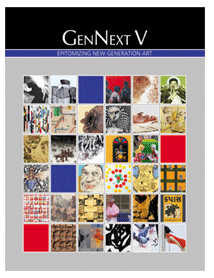 GenNext has already traveled to the global dais in its third anniversary and since then every year it has become a global event in the month of October when it is celebrated as an exhibition, workshop and a complete rendezvous for discourses to evolve at Aakriti Art Gallery in Kolkata.
GenNext has already traveled to the global dais in its third anniversary and since then every year it has become a global event in the month of October when it is celebrated as an exhibition, workshop and a complete rendezvous for discourses to evolve at Aakriti Art Gallery in Kolkata.
If we look into the history of the last century, we will come across several art movements in Europe and America that evolved and revolutionized the entire practice of art by changing the basic dynamics and parameters of aesthetic discourse. But for our country it took some more time, almost 30 to 50 years to embrace these changes and appropriate them accordingly. So there has always remained the risk factor of biased imitation without understanding the basis of why things have been done and executed in a particular way in the West. The relevance of contemporaneity or contextual identity is thus very significant in any given time and space for approaching and understanding any art work. And GenNext has always tried to be judicious in giving the right attempt to its concept and approach to expand to form a global identity.
Before going deep into the gradual evolution of GenNext shows, let's have a quick look at the history of modern art, so that evaluating the concept of GenNext with historical relevance can be done in a more meaningful way. Modernism is the broader connotation that overarches the art being practiced at the beginning of the twentieth century. All types of art from visual, performing, literary, music and so 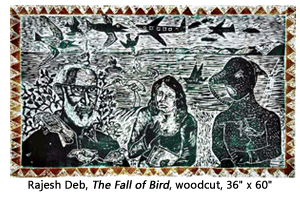 on before 1914 was rejected by modernism due to its stuffy traditional art of bearing the impressions of the previous century and in fact welcomed everything that was fresh, innovative and progressive in the modern era. If this was the situation in the earlier half of the twentieth century, the latter half of the twentieth reflected something else. This is the period in the history of art where painting was no longer seen purely as a literal, descriptive medium. Art found itself in the realm of ideas and since then onward artists could do anything and everything as art that was concerned to every aspect of what it means to be alive today. Art from 1980 onward became a great plurality of styles and ideas with the increasing access to the wealth of cultural material through the exponential growth in new technologies, mediums and especially the advent of the digital medium. This period is signified to be the most chaotic and confusing that on the other hand is the central idea of postmodernism where nothing has a fixed meaning. The postmodernist era has given artists the freedom to determine their choice of subject matter and the manner in which they choose to execute it. Postmodernism also means that artists borrow wholesale from previous styles, now that the idea of originality and authenticity is declining; it is precisely such ambiguity and doubt that are recognized as being at the core of things. Thus deconstruction, diversity and a recycling or appropriation of subject matter was hugely encouraged.
on before 1914 was rejected by modernism due to its stuffy traditional art of bearing the impressions of the previous century and in fact welcomed everything that was fresh, innovative and progressive in the modern era. If this was the situation in the earlier half of the twentieth century, the latter half of the twentieth reflected something else. This is the period in the history of art where painting was no longer seen purely as a literal, descriptive medium. Art found itself in the realm of ideas and since then onward artists could do anything and everything as art that was concerned to every aspect of what it means to be alive today. Art from 1980 onward became a great plurality of styles and ideas with the increasing access to the wealth of cultural material through the exponential growth in new technologies, mediums and especially the advent of the digital medium. This period is signified to be the most chaotic and confusing that on the other hand is the central idea of postmodernism where nothing has a fixed meaning. The postmodernist era has given artists the freedom to determine their choice of subject matter and the manner in which they choose to execute it. Postmodernism also means that artists borrow wholesale from previous styles, now that the idea of originality and authenticity is declining; it is precisely such ambiguity and doubt that are recognized as being at the core of things. Thus deconstruction, diversity and a recycling or appropriation of subject matter was hugely encouraged.
This is how, out of this practice took place the development of 'conceptual art' where nothing is bound by context, essentially 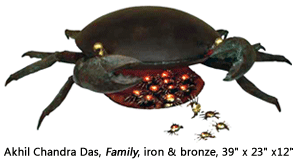 treated as a regional outcome or categorically placed within the limits of a boundary. The language of art has become more individualistic but with a very universal approach where an artwork from Croatia can get connected with that of China or from the UK with that of Pakistan. At the time of the 'glocal' (global + local) way of life, art has transcended from its local reality to the global sphere depicting things that have relevance in every corner of the globe or may be that doesn't require any type of bearing and identification to create a mass acceptance. In a broader perspective in India during the early twentieth century, art began with the revival of indigenous language and developing an individual style marking the Indian identity, the Bengal School came into existence and the imprints of this school remained more than half a century. But gradually from the late 1970s assimilation, absorption and appropriation of different trends, ideas, styles and ways of execution started getting place in the Indian art domain. A wide arena of thought process was introduced and in the last decade of the twentieth century, technology and digital medium also marked a significant change in the practicing, understanding and approaching the way of looking at art in this subcontinent.
treated as a regional outcome or categorically placed within the limits of a boundary. The language of art has become more individualistic but with a very universal approach where an artwork from Croatia can get connected with that of China or from the UK with that of Pakistan. At the time of the 'glocal' (global + local) way of life, art has transcended from its local reality to the global sphere depicting things that have relevance in every corner of the globe or may be that doesn't require any type of bearing and identification to create a mass acceptance. In a broader perspective in India during the early twentieth century, art began with the revival of indigenous language and developing an individual style marking the Indian identity, the Bengal School came into existence and the imprints of this school remained more than half a century. But gradually from the late 1970s assimilation, absorption and appropriation of different trends, ideas, styles and ways of execution started getting place in the Indian art domain. A wide arena of thought process was introduced and in the last decade of the twentieth century, technology and digital medium also marked a significant change in the practicing, understanding and approaching the way of looking at art in this subcontinent.
In the first decade of the twenty-first century, the concept was entirely revolutionized and private galleries as major patron of art started playing the key role in this whole enterprise. It would be rather impossible, today, to deny the corporeality approach working behind the evolution of art where video art, installations, interactive sculptures, work in new medium and digital prints etc that  started getting profusely acknowledged and accepted and scored high prices in the art market. And to bring forth the young contemporary creative talents to the forefront, galleries across the country have taken some kind of initiative or the other to extend the reach of new generation art beyond borders. Aakriti Art Gallery, Kolkata holds the benchmark position in this endeavour through its idea of hosting a show like GenNext that was devised by this gallery to promote the young talents across the globe on a common platform. It began in 2006 at its first anniversary and finally has stepped to its fifth edition this year in 2010. There is a definite procedure for the participation in this show where applications are submitted along with images of works for the final selection to take place. A selection procedure is maintained. Artists are selected by a panel of judges that includes art historian, critic, artist and connoisseur from the entries received within a stipulated time frame of the year.
started getting profusely acknowledged and accepted and scored high prices in the art market. And to bring forth the young contemporary creative talents to the forefront, galleries across the country have taken some kind of initiative or the other to extend the reach of new generation art beyond borders. Aakriti Art Gallery, Kolkata holds the benchmark position in this endeavour through its idea of hosting a show like GenNext that was devised by this gallery to promote the young talents across the globe on a common platform. It began in 2006 at its first anniversary and finally has stepped to its fifth edition this year in 2010. There is a definite procedure for the participation in this show where applications are submitted along with images of works for the final selection to take place. A selection procedure is maintained. Artists are selected by a panel of judges that includes art historian, critic, artist and connoisseur from the entries received within a stipulated time frame of the year.
In the first GenNext, artists were mainly selected from the eastern fringe of the country with prime focus on Kolkata. Akhil Chandra Das, Barun Chowdhury, Birendra Pani, Biswajit Mukherjee, Debanjan Roy, Debasis Barui, Debraj Goswami, Deepak Kundu, Dipendranath Pal, Farhad Hussain, Jayanta Paul, Jayanta Kumar Paul, Jayanta Roy, Nobina Gupta, Prasun Ghosh, Rajesh Bhowmik, Rajesh Deb, Ritendra Roy, Sandip Daptari, Soumit Gupta, Soumen Das, Sourav Jana, Subrata Biswas, Sujit Kumar Karan, Supam Adhikary,  Sutanu Chatterjee and Tapas Biswas were the participants.
Sutanu Chatterjee and Tapas Biswas were the participants.
These thirty seven emerging painters, sculptors and printmakers executed their creative potential to generate an enriching experience for the art lovers of the city. The GenNext dais also became a turning point for many of these participants who now excel in the art world and their art works are auctioned on international platform. Debraj Goswami, Birendra Pani, Farhad Hussain are among the most promising young contemporaries right now exhibiting their works across the globe with accolades with appreciating worth in the art market. Sculptors like Tapas Biswas, Akhil Chandra Das and Subrata Biswas, Debanjan Roy have evolved with a new genre of sculpting making differences yet through classical touch. Their works too are applauded across the nation as well as in other continents of the globe. Crossing boundaries with liberated thoughts, experimentation with mediums and development of new language has by now become the inherent motto of the GenNext shows.
GenNext II grew up in the form of a national event in the year 2007. In a much panoramic outlook, again a bunch of thirty seven young talents got the opportunity to execute their intellect and creativity on this lucrative platform. The gallery took every bit of initiative to reach out and give right promotional treatment to this contemporary flavour. The whole show became a mixed bag of content and style, a confluence of old and new thoughts and techniques, an amalgamation of various trends and also an attempt to way to self-expression that sometimes turned out to be very discreet. This time the participants were Abdul Salam, Akhil Chandra Das, Amlan Dutta, Anasuya Chakraborty, Ankur Khare, Apu Dasgupta, Arya Oraw, Ashish Ghosh, Avijit Dutta, Balaka Bhattacharjee, Chandan Bhandari, Chandan Das, Debasis Barui, Dipak Kundu, Jayanta Kumar Paul, Krishna Sardar, Madhuri Kathe, Mithun Dasgupta, Nobina Gupta, Pallab Das, Pradip Mondal, Rajesh Bhowmik, Rishav Gandhar Narzary, Rupal Dave, S Gopinath, Sandip Daptari, Shantanu Mitra, Shyamal Roy Chowdhury, Somit Gupta, Somnath Adhikary, Sourav Jana, Subrata Biswas, Sujit Kumar Karan, Sumana Ghosh, Suman Choudhury, Supam Adhikary, Tapas Biswas, Tarun Maity, Vivek Sharma.
creativity on this lucrative platform. The gallery took every bit of initiative to reach out and give right promotional treatment to this contemporary flavour. The whole show became a mixed bag of content and style, a confluence of old and new thoughts and techniques, an amalgamation of various trends and also an attempt to way to self-expression that sometimes turned out to be very discreet. This time the participants were Abdul Salam, Akhil Chandra Das, Amlan Dutta, Anasuya Chakraborty, Ankur Khare, Apu Dasgupta, Arya Oraw, Ashish Ghosh, Avijit Dutta, Balaka Bhattacharjee, Chandan Bhandari, Chandan Das, Debasis Barui, Dipak Kundu, Jayanta Kumar Paul, Krishna Sardar, Madhuri Kathe, Mithun Dasgupta, Nobina Gupta, Pallab Das, Pradip Mondal, Rajesh Bhowmik, Rishav Gandhar Narzary, Rupal Dave, S Gopinath, Sandip Daptari, Shantanu Mitra, Shyamal Roy Chowdhury, Somit Gupta, Somnath Adhikary, Sourav Jana, Subrata Biswas, Sujit Kumar Karan, Sumana Ghosh, Suman Choudhury, Supam Adhikary, Tapas Biswas, Tarun Maity, Vivek Sharma.
The GenNext III evolved as a global phenomenon. In 2008, there were almost eight hundred entries received from young artists below forty across the globe. Among them only forty were finally selected. They were Amit Kalla, Anirban Dasmahapatra, Banatanwi Dasmahapatra, Bhabotosh Sutar, Chandan Bhandary, Hemraj, Jayanta Bhattacharya, K Prasun Roy, Ketan N Amin, Korou KH, Moutushi Chakraborty, Tushar Waghela, Muktinath Mondal, Nantu Behari Das, P Bardhan, Prandeep Kalita, Prithwiraj Mali, Priyanka Lahiri, Rajen Mondal, 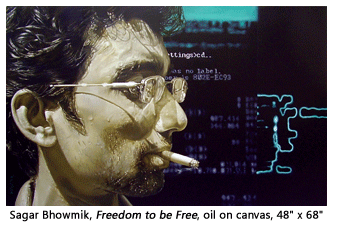 Sanhita Banerjee, Sanhita Ghosh, Sanjoy Das, Santosh D Andrade, Saptarshi Naskar, Vijay D Kadam, Snehashish Maity, Suman Kabiraj, Sutanuka Giri, Tisha Mondal from different corners of India. Mathew Tom, Ashraful Hasan, I V Toshain, Maciej Gador, Asim Amjad, Dionne Simpson, Serena Scapagnini, Gregory Chenu Vidal, Joarez Filho, Sian Amoy and Justin Tyler Tate from abroad. From this show artists like Nantu Behari Das, Priyanka Lahiri, Ketan Amin, Saptarshi Naskar's works are being showcased by different galleries across the nation and their works are being widely acclaimed. This particular exhibition showed the gateway to the notion of 'conceptual art' and the works were related to specific psychological associations. This comparative study of artworks from all around the world became the crux behind the conceptualization of GenNext III, and the show rocked the art world with a revolutionary instinct.
Sanhita Banerjee, Sanhita Ghosh, Sanjoy Das, Santosh D Andrade, Saptarshi Naskar, Vijay D Kadam, Snehashish Maity, Suman Kabiraj, Sutanuka Giri, Tisha Mondal from different corners of India. Mathew Tom, Ashraful Hasan, I V Toshain, Maciej Gador, Asim Amjad, Dionne Simpson, Serena Scapagnini, Gregory Chenu Vidal, Joarez Filho, Sian Amoy and Justin Tyler Tate from abroad. From this show artists like Nantu Behari Das, Priyanka Lahiri, Ketan Amin, Saptarshi Naskar's works are being showcased by different galleries across the nation and their works are being widely acclaimed. This particular exhibition showed the gateway to the notion of 'conceptual art' and the works were related to specific psychological associations. This comparative study of artworks from all around the world became the crux behind the conceptualization of GenNext III, and the show rocked the art world with a revolutionary instinct.
The fourth GenNext invoked another new discourse where thirty four versatile creative minds met together for the sake of the common cause to boost the new generation art movement. This time artists from USA, South Korea, Hungary and far eastern states of India came together to raise a novel hue through their creative discourse. Around six hundred entries from artists across the globe had been received and a panel of experts went for a rigorous grueling of their creative effort and finally thirty four were selected to participate in this enthralling platform. The selected artists were Aharon Rothchild, Amit Kumar Debnath, Atul B Mahajan, Barun Pramanik, Debasish Datta, Debasish Sarkar, Dipta Bhattacharya, Huma Mulji, Jaishri Abichandani, Kondor Valéria, Mansoor Ali Makrani, Mantu Das, Nabanita Dutta Guha, Nantu Behari Das, Oli Ghosh, Paltu Barman, Partha Guin, Piyali Sadhukhan, Prafull Singh, Prandeep Kalita, Priti Kahar, Priyanka Lahiri, Pramod Kumar Singh, Punyo Chobin, Romicon Revola, Ruth Avra Kleinman & Dana Lynn Kleinman (KX2), Sagar Bhowmik, Sanhita Banerjee, Siraj Saxena, Soma Das, Sujit Karmakar, Sukanya Ghosh, Tushar Kanti Pradhan and Youn Mi Ock.
This time artists from USA, South Korea, Hungary and far eastern states of India came together to raise a novel hue through their creative discourse. Around six hundred entries from artists across the globe had been received and a panel of experts went for a rigorous grueling of their creative effort and finally thirty four were selected to participate in this enthralling platform. The selected artists were Aharon Rothchild, Amit Kumar Debnath, Atul B Mahajan, Barun Pramanik, Debasish Datta, Debasish Sarkar, Dipta Bhattacharya, Huma Mulji, Jaishri Abichandani, Kondor Valéria, Mansoor Ali Makrani, Mantu Das, Nabanita Dutta Guha, Nantu Behari Das, Oli Ghosh, Paltu Barman, Partha Guin, Piyali Sadhukhan, Prafull Singh, Prandeep Kalita, Priti Kahar, Priyanka Lahiri, Pramod Kumar Singh, Punyo Chobin, Romicon Revola, Ruth Avra Kleinman & Dana Lynn Kleinman (KX2), Sagar Bhowmik, Sanhita Banerjee, Siraj Saxena, Soma Das, Sujit Karmakar, Sukanya Ghosh, Tushar Kanti Pradhan and Youn Mi Ock.
The fifth anniversary of the Aakriti Art Gallery brought forward another fresh bunch of thirty four artists from different corners of the country along with China, UK, Croatia, France and Italy.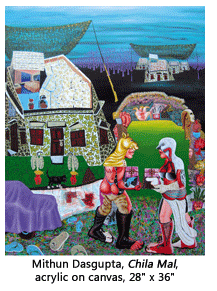 With other events like symposium on global issues related to art and its democratic propagation, workshop, interactive sessions, GenNext V was able to set new dialectics in the art world in this postmodern ear. The participants were Arindam Sarkar, Annabel Scheneck, Buddhadev Mukherjee, Chandranath Saha, Debasree Das, Dino Bakic, D Dashan, Deepak Khetri, H G Ganesh Urala, Kaite Helps, Kasa Vinay Kumar, Krupa Makhija, Laura Guoke, Mithun Dasgupta, Meenakshi Sengupta, Mohan Kumar T, Mrinal Dey, Muktinath Mondal, Nabanita Guha, Prabhakar Alok, Ramello, Ranjan Ghosh, Riya Chatterjee, Rupa Rani, S Thakur, Santosh Anddrade, Sayed Naqvi, Sayak Mitra, Siraj Saxena, Shyamaprasad Bhattacharya, Soghra Khurasani, Vinita Dasgupta, Tisha Mondal and Yu Zhaonang. The plethora of thinking ability and the fusion of every unique discourse of the participating artists in the GenNext exhibitions have always bred insightful imprints in the art history to embark the broader connotation of the intellectual effervescence of new generation art to the whole world with the hope to incite a new direction in the art world.
With other events like symposium on global issues related to art and its democratic propagation, workshop, interactive sessions, GenNext V was able to set new dialectics in the art world in this postmodern ear. The participants were Arindam Sarkar, Annabel Scheneck, Buddhadev Mukherjee, Chandranath Saha, Debasree Das, Dino Bakic, D Dashan, Deepak Khetri, H G Ganesh Urala, Kaite Helps, Kasa Vinay Kumar, Krupa Makhija, Laura Guoke, Mithun Dasgupta, Meenakshi Sengupta, Mohan Kumar T, Mrinal Dey, Muktinath Mondal, Nabanita Guha, Prabhakar Alok, Ramello, Ranjan Ghosh, Riya Chatterjee, Rupa Rani, S Thakur, Santosh Anddrade, Sayed Naqvi, Sayak Mitra, Siraj Saxena, Shyamaprasad Bhattacharya, Soghra Khurasani, Vinita Dasgupta, Tisha Mondal and Yu Zhaonang. The plethora of thinking ability and the fusion of every unique discourse of the participating artists in the GenNext exhibitions have always bred insightful imprints in the art history to embark the broader connotation of the intellectual effervescence of new generation art to the whole world with the hope to incite a new direction in the art world.